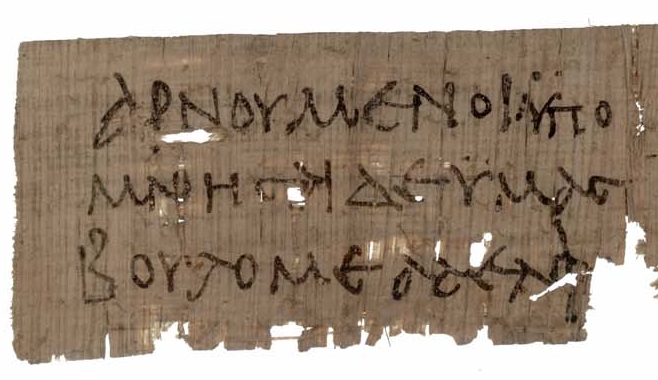Here is Jude 5 from the NA28: Ὑπομνῆσαι δὲ ὑμᾶς βούλομαι, εἰδότας ὑμᾶς ἅπαξ πάντα ὅτι Ἰησοῦς λαὸν ἐκ γῆς Αἰγύπτου σώσας τὸ δεύτερον τοὺς μὴ πιστεύσαντας ἀπώλεσεν.
Below is Jude 5 in p72. Good luck in reading it. Note the faint read line where the first word starts and the red line where the verse ends.
Now take note of the two underlined nomina sacra, θC XΡC, or "God Christ."
This is called a "singular reading" because it is found in no other Greek manuscript.
Image courtesy of CSNTM.
- Hi Dr. V. I was reading in Comfort's "Encountering the manuscripts", pg 223, regarding the nomina sacra XPC, or what he calls the "longer contracted form". He mentions P78 of Jude, dated early 4th century, and which contains a fragment of Jude. I went over to the CSNTM site to study P78. I could not locate the contracted form (the papyri are very difficult for me to read, but I'm trying!). If I'm on a rabbit trail here, my apologies. Anyway, I saw the first half of verse 5, but it cuts off right before the spot we are looking at. Anyhow, with the longer contracted form existing (per Comfort) in a manuscript of the same date, would this possibly explain from a dating standpoint why we see the longer contracted form of XPC along with IC in P72? Here is the link. http://www.csntm.org/manuscript/zoomify/GA_P78?image=P78_0003b.jpg&page=0#viewer
- Here is the entire transcription of p78 from another of Comfort's books: 4γιαν και τον μο νον δεσποτην και κ̅ν̅ ημων ι̅η̅ν̅ χ̅ρ̅ν̅ αρνουμενοι· 5ϋπο μνησαι δε ϋμας βουλομε αδελφο̣ι̣ [verses 5b–7a missing due to the loss of four leaves or one folio] 7αιωνιου δικην επεχουσαι 8ομοιως μεντοι και ουτοι ενϋπνειαζομε νοι σαρκα μεν μι αινουσιν κυρει οτητα δε αθετου σιν δοξαν̣ δε [βλα Text of the Earliest New Testament Greek Manuscripts
- Cool. Thanks!
